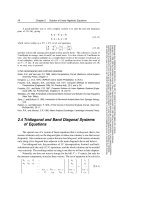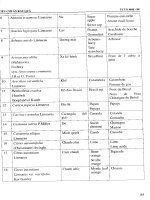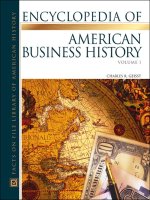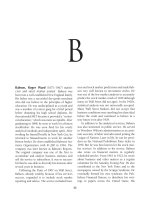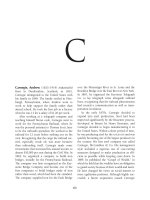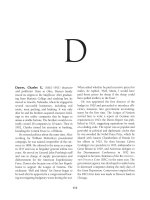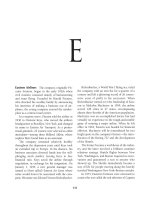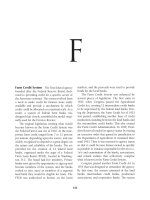Encyclopedia of american business history part 5 docx
Bạn đang xem bản rút gọn của tài liệu. Xem và tải ngay bản đầy đủ của tài liệu tại đây (122.15 KB, 12 trang )
131
E
Eastern Airlines The company, originally Pit-
cairn Aviation, began in the early 1920s when
civil aviation consisted mainly of barnstorming
and stunt flying. Founded by Harold Pitcairn,
who shocked his wealthy family by announcing
his intention of making a business out of air-
planes, the young company entered the market-
place as a contract mail carrier.
In a surprise move, Pitcairn sold the airline in
1930 to Clement Keys, who moved the airline’s
headquarters to Brooklyn, New York, and changed
its name to Eastern Air Transport. As a promo-
tional gimmick, 22 women were selected as cabin
attendants—among them Mildred Aldrin, whose
nephew Buzz found fame as an astronaut.
The company remained relatively healthy
throughout the depression years until Keys took
an extended trip to Europe. In his absence, his
business associates diverted funds into the still-
plunging stock market, leaving Keys to face
financial ruin. Keys saved the airline through
negotiation, in exchange for his resignation. On
January 1, 1935, a new general manager was
named to (then called) Eastern Air Lines whose
name would forever be associated with the com-
pany. His name was Edward Vernon Rickenbacker.
Rickenbacker, a World War I flying ace, ruled
the company with an iron fist for a quarter of a
century and left a glittering record of 26 consec-
utive years of profit to his successors. When
Rickenbacker turned over the leadership of East-
ern to Malcolm MacIntyre in 1959, the airline
served 128 cities in 27 states, encompassing
almost three-fourths of the American population.
MacIntyre was an accomplished lawyer but had
virtually no experience in the rough-and-tumble
game of running a major airline. When he left
office in 1963, Eastern was headed for financial
oblivion. MacIntyre will be remembered for two
bright spots in the company’s history—the intro-
duction of the Boeing 727 and the development
of the Shuttle.
The former became a workhorse of the indus-
try, and the latter involved a brilliant customer
relations strategy. Shuttle flights between New
York, Washington, and Boston required no reser-
vations and guaranteed a seat to anyone who
showed up. The Shuttle immediately became a
way of life for people moving along the heavily
traveled Washington–New York–Boston corridor.
In 1975, Eastern’s fortunes were entrusted to
a man who was called the real inheritor of Captain
Eddie’s leadership mantle—former astronaut
Colonel Frank Borman. As president and CEO,
Borman brought a familiar military ethic back to
Eastern. He negotiated wage concessions from
the employees in an attempt to save the company
from disaster, but failed to compensate for the
exorbitant cost of the new airplanes he had
ordered or the costly effects of DEREGULATION.
Borman and Eastern’s machinist unions clashed
furiously and frequently.
Industry analysts blamed Eastern’s troubles
partly on poor management and partly on the
company’s uncooperative labor unions, but the
root of Eastern’s troubles lay in a poor route
structure and huge debt. As a result of these
seemingly incurable financial distresses, Eastern
succumbed to a takeover bid by Frank Lorenzo
and his Texas Air empire. The conflict over Texas
Air’s acquisition extended to several employee
groups and proved to be the beginning of the end
for Eastern.
A period of severe employee unrest followed.
In March 1989, a strike against the airline was
called by the machinists and supported by the
flight attendants and the pilots. A week later, East-
ern filed for
BANKRUPTCY, and its management
fought to retain control over Eastern in the face of
furious resistance from labor and rapidly diminish-
ing confidence among its investors. In April 1990,
bankruptcy court judge Burton Lifland ruled that
Frank Lorenzo, the brash corporate raider who
had acquired Eastern, was unfit to run the com-
pany and appointed a trustee for the airline. A last-
ditch effort for order failed, and on January 18,
1991, the company folded its wings for good.
See also AIRLINE INDUSTRY;PAN AMERICAN
AIRWAYS.
Further reading
Bernstein, Aaron. Grounded: Frank Lorenzo and the
Destruction of Eastern Airlines. New York: Simon
& Schuster
, 1990.
Saunders, Martha Dunagin. Eastern’s Armageddon:
Labor Conflict and the Destruction of Eastern Air-
lines. New York: Greenwood Press, 1992.
Serling, Rober
t J. From the Captain to the Colonel: An
Informal Histor
y of Eastern Airlines. New York:
Doubleday
, 1980.
Martha Dunagin Saunders
Eastman, George (1854–1932) businessman
Born in Waterville, New York, Eastman moved to
Rochester with his family as a young boy. The
death of his father forced him to leave school at
age 14 and find work as a messenger. While
working in that capacity, he studied accounting
in the evenings and gradually worked his way up
to the position of clerk in a Rochester bank. But
it was not until his first planned vacation that he
became interested in photography.
He bought his first camera for a vacation that
was never to take place. The large, cumbersome
camera he purchased intrigued him, however,
and he decided to improve upon the design of
the photographic plates that were until that time
covered with gelatin. By 1880, he had devised a
process for dry plates and opened up shop in
Rochester to manufacture them for sale to other
camera manufacturers, initially operating as a
partnership called the Eastman Dry Plate Co.
After manufacturing plates for several years, he
hit upon the idea of producing film on a roll,
which in turn would help make cameras smaller.
He began producing film in 1885. Three years
later, he produced the first Kodak camera, which
was unique for being able to be operated with the
click of a simple button. The trademark name
was registered and quickly became synonymous
with photography itself.
The original camera had film installed capa-
ble of taking 100 pictures. The price was $25.
When the customer used the entire roll of film, it
was returned to the factory, where the film was
developed and the camera reloaded before being
returned to its owner. Previous partnerships gave
way to the Eastman Co. in 1889 and finally the
Eastman Kodak Co. in 1892. Eastman served as
chairman of the company’s board from 1925 to
1932.
132 Eastman, George
From the beginning, Eastman emphasized
MASS PRODUCTION combined with low costs so
that he could reach as wide a market as possible.
He was also much more generous to his employ-
ees than many other industrialists of the period.
As early as 1899, he began distributing a portion
of his own profit to his employees. He later estab-
lished a program called the “wage dividend” that
paid each employee a percentage equivalent to
the common stock dividends above his or her
salary. After World War I, he gave one-third of
his stock holdings to his employees. The gift was
worth about $110 million.
Eastman Kodak Company became the largest
American producer of cameras and film until
challenged by the Polaroid Co., founded by
Edwin L
AND, and later by imports, mostly from
Japan. Eastman remained a generous philanthro-
pist throughout his life. He was a major benefac-
tor to the University of Rochester, M.I.T.,
Hampton Institute, and Tuskegee Institute. The
University of Rochester was the main beneficiary,
especially its Eastman School of Music. He died
in 1932.
Further reading
Brayer, Elizabeth. George Eastman: A Biography. Balti-
more: Johns Hopkins University Press, 1996.
Swasy, Alecia. Changing Focus: Kodak and the Battle to
Save a Gr
eat American Company. New York: Ran-
dom House, 1997.
T
edlow, Richard S. Giants of Enterprise: Seven Business
Innovators and the Empir
es They Built. New York:
HarperBusiness, 2001.
Eaton, Cyrus (1883–1979) financier and
industrialist Born in Nova Scotia, Eaton was a
member of an established New England family
that moved to Canada in 1760. He graduated
from Amherst Academy in Ontario and decided
to become a Baptist minister. After graduation,
he visited an uncle who was a Baptist minister in
Cleveland, where he was introduced to John D.
Rockefeller, a member of his uncle’s congrega-
tion. After working at a summer job for Rocke-
feller, he was persuaded to attend McMaster Uni-
versity and study business. He graduated in 1905
and went to work for Rockefeller after a brief
series of odd jobs.
Eaton began working for Rockefeller in Man-
itoba in 1907. He was put in charge of acquiring
franchises for power plants in Canada, although
the Panic of 1907 intervened, and Rockefeller
was unwilling to pursue the enterprise. Eaton
then assumed part of the project himself, bor-
rowed money, and built a power plant in Mani-
toba. He soon followed this success by building
other plants, and he eventually established the
Continental Gas and Electric Company with
holdings in the United States and Canada.
In 1913, he returned to Cleveland and estab-
lished a partnership in the investment banking
firm Otis & Company. Over the next 10 years,
Eaton became one of the major investors in the
UTILITIES industry, which was expanding rapidly
in the 1920s. He merged Continental Gas and
Electric with the Kansas City Power and Light
Co. and the Columbia Power and Light Co. to
form United Light and Power, a giant utility that
served more than 5 million people in a dozen
midwestern states.
During the late 1920s, Eaton was best
remembered for engaging in a takeover battle
with Samuel INSULL for Insull’s holdings in the
Commonwealth Edison Company. In order to
fend off Eaton’s unwanted advances, Insull was
forced to seek the help of New York bankers,
who forced his downfall and the notable bank-
ruptcy filing that followed in the early 1930s. He
also entered the STEEL INDUSTRY in the 1920s and
merged several smaller companies into the
Republic Steel Corporation, destined to become
one of the country’s largest producers. The same
year that he created Republic, he also took con-
trol of the Goodyear Tire and Rubber Company.
The stock market crash of 1929 reputedly
cost Eaton more than $100 million in losses.
Three years later, he became associated with
Harold Stuart of the Chicago investment banking
Eaton, Cyrus 133
firm Halsey Stuart & Co. Halsey Stuart was the
former financier of much of Insull’s utilities
empire. One of the firm’s major contributions to
finance during this period was the introduction
of competitive bids for underwriting mandates
for new securities issues, especially in the rail-
road industry, which was later made standard by
the Securities and Exchange Commission.
In his later years, Eaton remained active in
industry by becoming the chairman of the
Chesapeake & Ohio Railroad and the Kaiser-
Frazer Automobile Co. after World War II. He
also developed a close relationship with the
Soviet Union and organized a series of meetings
at his home in Nova Scotia between American
and Soviet scientists designed to ease world ten-
sions. These meetings became known as the Pug-
wash Conferences. He also helped develop the St.
Lawrence Seaway.
Further reading
Allen, Frederick Lewis. The Lords of Creation. New
York: Harper & Brothers, 1935.
Gleisser
, Marcus. The World of Cyrus Eaton. New York:
A. S. Barnes, 1965.
Eccles, Marriner S. (1890–1977) business-
man and banker Born in Logan, Utah, Eccles
was the oldest of nine children. After attending
Brigham Young College, he became familiar with
investments and established an investment com-
pany that acquired many of his father’s successful
business enterprises. In 1924, he and his brother
joined with a prominent banking family in Utah to
form the Eccles-Browning Affiliated Banks, which
rapidly began to expand by acquiring banks in
Utah and Wyoming. In 1928, he and several part-
ners organized the First Security Corporation, a
HOLDING COMPANY that managed the acquired
banks. The company was one of the first multi-
bank holding companies in the United States.
Eccles’s banks survived the Great Depression
without serious disruption, and he became the
most prominent banker in the West during the
1930s. A Republican until the early 1930s, he
shared many of the Roosevelt administration’s
goals and became an avid supporter of the
Democrats. He helped the administration draft
the Emergency Banking Act of 1933, the Federal
Housing Act of 1934, and the B
ANKING ACTOF
1933 (Glass-Steagall Act). As a result of his public
service, Eccles was named chairman of the Fed-
eral Reserve System in 1934 and assumed the
position in 1935 after being confirmed.
He was also the principal force behind the
Banking Act of 1935, which reorganized the Fed-
eral Reserve System. Since its inception, the cen-
tral bank had been criticized in many quarters as
being elitist, but it lacked power in many crucial
areas that would allow it to maintain control of
the creation of money and credit. The central bank
was restructured by the 1935 act and given spe-
cific powers that were lacking during the 1920s
and were widely blamed for contributing to the
1929 crash. The Fed was now allowed to perform
system repurchase agreements. Prior to the law,
the branches could perform open market opera-
tions, undoing board policy as the New York Fed-
eral Reserve Bank had done in 1929. The Fed’s
membership also was redesigned so that members
of the board would be full-time employees.
After World War II, Eccles helped work on
the agreements drawn up at Bretton Woods, New
Hampshire, that created the World Bank and
International Monetary Fund. In 1948, President
Truman did not reappoint him chairman of the
Fed, but he remained as vice chairman until
1951, when he resigned. He died in Salt Lake
City in 1977.
Eccles is widely remembered as a successful
banker with wide practical experience, which
eventually contributed to the most significant
reforms of the F
EDERAL RESERVE since it was
founded. The Federal Reserve building in Wash-
ington, D.C., is named in his honor.
Further reading
Eccles, Marriner S. Beckoning Frontiers: Public and Per-
sonal Recollections. New York: Knopf, 1951.
134 Eccles, Marriner S.
Hyman, Sidney. Marriner S. Eccles: Private Entrepre-
neur and Public Servant. Palo Alto, Calif.: Stanford
University School of Business, 1976.
Edison, Thomas A. (1847–1931) inventor
Born in Milan, Ohio, to Samuel and Nancy Elliott
Edison, Edison began experimenting while still a
child. Not academically talented as a child, his
mother often instructed him at home, and he
developed an early interest in chemistry. He sold
sundries on trains to earn money and suffered an
accident that caused lifetime deafness. After
learning how to telegraph messages from a rail-
way agent, he took a job as a telegraph agent in
Canada before returning to the United States.
After working at a series of jobs as a telegraph
operator, he began inventing and patented a
stock TICKER TAPE machine. While working in
New York City, he made improvements for a
stock ticker while working for the Gold Indicator
Company. The patents he registered were sold to
his employer for $40,000, and he promptly took
the proceeds and opened a workshop in Newark,
New Jersey.
While in Newark, Edison improved the stock
ticker and also made substantial improvements
for the TYPEWRITER. Both developments helped
increase business efficiency once the devices were
put into use. Shortly thereafter, he moved his
headquarters to Menlo Park, New Jersey, where
he made improvements on the telephone. His
most important invention to date was the phono-
graph, which he invented as a way to record
telegraph messages, but it was the electric incan-
descent bulb that earned him the nickname “The
Wizard of Menlo Park.” In 1879, he succeeded in
placing a filament in a bulb that burned for many
hours before going out. He was also one of the
first developers of the electric chair, bringing him
into direct competition with George WESTING-
HOUSE. Edison’s version of the electrocution
device used direct current (DC), while Westing-
house’s used alternating current (AC) and eventu-
ally became the standard model used.
In 1887, Edison moved his laboratories to
West Orange, New Jersey, and continued to
invent while perfecting his older inventions. He
also spent considerable time marketing his
ideas. The electric lightbulb was only a part of
the process of electric generation, and Edison
spent considerable time organizing power sta-
tions to support his invention. The first power
station in New York City was at Pearl Street,
near Wall Street, and J. P. Morgan was the first
user of the power that it generated. Morgan
later bought Edison’s operation, freeing the
inventor from business matters, and used it as
the basis for the G
ENERAL ELECTRIC CO. Edison’s
assistant at the time was Samuel INSULL, who
would later build a massive UTILITIES empire in
Chicago.
Using research first developed by George
EASTMAN, Edison also invented the motion pic-
ture camera. He connected the phonograph and
the camera in order to produce talking pictures
Edison, Thomas A. 135
Thomas Edison and his original dynamo, Orange, New
Jersey, 1906 (L
IBRARY OF CONGRESS)
but was less interested in this development than
others. During his lifetime, he also was responsi-
ble for developing the dictaphone, allowing sec-
retaries to transcribe messages from a machine
that recorded voices, and a duplicating machine,
among many other inventions.
Edison’s original company, the Edison Gen-
eral Electric Company, was later consolidated by
J. P. Morgan with the Thompson-Houston Com-
pany to become the General Electric Company.
During World War I, Edison was president of the
Naval Consulting Board and conducted research
on torpedoes and submarine periscopes. As a
result of his research, he was awarded the Distin-
guished Service Medal. He died in West Orange
in 1931, the most prolific and celebrated inven-
tor of modern times.
See also M
ORGAN, JOHN PIERPONT.
Further reading
Baldwin, Neil. Edison: Inventing the Century. New York:
Hyperion, 1995.
Israel, Paul. Edison: A Life of Invention. New York: John
W
iley & Sons, 1998.
Jonnes, Jill. Empires of Light: Edison, Tesla, Westing-
house, and the Race to Electrify the World. New
Y
ork: Random House, 2003.
Enron Corporation An energy company cre-
ated in 1985 with the merger of the Houston Nat-
ural Gas Co. and InterNorth Corp. of Omaha,
integrating several pipeline companies to create
the first nationwide natural gas pipeline system.
A year later, Kenneth Lay became the chief exec-
utive officer, and the company officially chose
Enron as its name.
In 1987, the company began developing risk
reduction techniques to protect itself against the
fluctuating prices of gas and oil. It also began
offering customers the ability to buy long-term
gas contracts at fixed prices and began diversify-
ing itself internationally, especially in Britain and
South America. In 1994, it entered the electricity
trading market after the DEREGULATION caused by
the Energy Policy Act of 1992. As a direct result,
throughout the 1990s the company continued to
acquire
UTILITIES companies, including the Dab-
hol power plant in India and Wessex Water in
Britain. It also expanded into the domestic utili-
ties business by purchasing the Portland General
Electric Corp. in 1997 in a much-contested
acquisition pitting the company against Oregon’s
utilities board.
Jeffrey Skilling joined the company in 1989
and was elected president and chief operating
officer in 1996. The company continued to make
acquisitions during the later 1990s as a deliberate
strategy of growing through merger. In 1999, the
company initiated a broadband services group
and began trading energy through an on-line Web
site, which quickly became the largest e-business
site in the world. By 2000, annual revenues had
reached $100 billion, much of it provided by
energy trading. Within a year, the company was
reported to be the sixth-largest energy company
in the world and ranked in the top 10 largest U.S.
companies measured by assets.
In the fall of 2001, fortunes began to change
at Enron when it announced more than $1 bil-
lion in charges for the third quarter and the Secu-
rities and Exchange Commission began an
inquiry into its affairs, including special invest-
ment partnerships Enron had created over the
preceding years. Then it announced that it would
have to restate its earnings for the previous four
years. It was subsequently discovered that the
company had engaged in massive fraud regarding
its earnings. Its stock price plummeted in the
market. Its bankruptcy filing following these dis-
coveries was the largest in U.S. history at the
time and prompted the S
ARBANES-OXLEY ACT,
passed by Congress to monitor the activities of
accountants and directors of public companies.
The company’s accountant, Arthur Andersen &
Co., was also sued by the Justice Department and
was subsequently disbanded for its role in help-
ing Enron shred documents deemed vital for the
investigation ordered by the Securities and
Exchange Commission.
136 Enron Corporation
Further reading
Fox, Loren. Enron: The Rise and Fall. New York: John
Wiley & Sons, 2002.
Swartz, Mimi, and Sherron Watkins. Power Failure:
The Inside Stor
y of the Collapse of Enron. New
Y
ork: Doubleday, 2003.
Erie Canal The first major inland waterway
built in the United States. Canals became the first
commonly used method of transporting goods in
America, especially from areas that were located
between two bodies of water. They quickly
replaced the TURNPIKES that had been built
decades before but proved expensive to build and
maintain. The Erie crossed New York State from
Buffalo to the Hudson River, covering 363 miles.
It was completed in 1825 at a cost of $7.1 million
and completely funded by New York. Some other
smaller canals were funded by private investors,
such as the Morris Canal in New Jersey. Origi-
nally, the Erie Canal charged tolls of about a cent
and a half per mile, but tolls finally were aban-
doned in 1882.
The canal opened New York State to com-
merce from the Hudson River to Lake Erie and
helped develop it into a major commercial and
financial center. This was just as vital to the area’s
commerce as the St. Lawrence Seaway would be
in the 20th century. Although the idea had circu-
lated for years in New York, DeWitt Clinton
(1769–1828) was responsible for planning and
developing the canal. Originally, he and Gou-
verneur Morris petitioned Washington for help
in building the canal but were denied. Then he
petitioned New York, which was much more
amenable to the proposal. Clinton was appointed
the head of a canal commission. The canal
received substantially more support when Clin-
ton was elected governor in 1817, and ground
was finally broken for construction. The canal
was completed eight years later, and Clinton was
aboard the first boat to navigate it, taking nine
days to make the journey. The opening of the
canal was a national event, and news of its open-
ing traveled quickly throughout the country. The
stocks of canals also became popular investments
on the stock exchanges.
Canals were quickly overtaken by
RAILROADS
before the Civil War as a means of transportation
but nevertheless remained popular throughout
most of the 19th century, remaining as a symbol
of economic growth and bringing goods to mar-
ket as quickly as possible. The Erie was enlarged
several times in order to make it more accommo-
dating for increased trade and larger barges. New
York finally incorporated the Erie into the New
York State Barge Canal System in 1918, merging
it with several other smaller canals connecting
many of the lakes in the interior of the state.
In addition to building the canal and serving
as governor (1817–22 and 1825–28), Clinton
was also a state assemblyman, state senator, and
mayor of New York City (1803–15). While
mayor, he established the New York City school
system. The Erie Canal remains his most note-
worthy achievement.
Further reading
Cornog, Evan. The Birth of Empire: DeWitt Clinton and
the American Experience, 1769–1828. New York:
Oxfor
d University Press, 1998.
Shaw, Ronald E. Erie Water West. Lexington: Univer-
sity Press of Kentucky
, 1966.
Sheriff, Carol. The Artificial River: The Erie Canal and
the Paradox of Progress, 1817–1862. New York:
Hill & W
ang, 1996.
Erie Railroad Company In 1851, the first
unit of the later Erie Railway System opened
under the corporate banner of the New-York &
Erie Railway Company. At the time, this 447-mile,
broad-gauge (six feet) line between the “ocean
and the lake” was touted as the “technological
marvel of the age.” Specifically, the Erie built
across the rugged “Southern Tier” of New York
counties from the village of Piermont, located on
the Hudson River about 25 miles north of New
York City, to Dunkirk, a small community on Lake
Erie Railroad Company 137
Erie southwest of Buffalo. While likely a routing
mistake, the company subsequently strengthened
its position with entry to the Port of New York at
Jersey City, New Jersey, and also at Buffalo.
Because of bad management and other factors, the
“first” Erie fell into BANKRUPTCY in 1859. The reor-
ganized company, the Erie Railway, never became
the profitable property that its leaders had
expected, and this led to a battle for control
among speculator Daniel D
REW, “Commodore”
Cornelius VANDERBILT of the New York Central &
Hudson River Railroad, and the stock traders
“Jim” FISK and Jay GOULD. The so-called Great
Erie War, which erupted in 1867, created addi-
tional financial problems, but when the victorious
Gould took control, he made it a much better
property. “[Before Gould] its iron was worn and
its roadbed in bad order,” reported the Railroad
Gazette in 1871. “There is now no better track in
America. Then it was scarcely safe to run twenty
miles an hour; now the road is as safe at forty-five
miles as human precaution can make it.”
Unfortunately for both the Erie and Gould,
the “scarlet woman of Wall Street” image forever
haunted them. In the early 1870s the talented
Gould left the Erie, and the road limped along
under ineffectual leadership until entering its sec-
ond bankruptcy. The widespread depression trig-
gered by the Panic of 1873 caused the property to
experience serious financial woes. By the end of
the decade a better day had dawned for the Erie,
reorganized in 1878 as the New York, Lake Erie &
Western Railroad. Modernization of rail and
rolling stock, standardization of gauge at four feet
8.5 inches, and creation of an expanded albeit
patchwork system that featured a nearly 1,000-
mile mainline between Jersey City and Chicago,
Illinois, encouraged investors, employees, and cus-
tomers. But hard times returned in the wake of the
catastrophic Panic of 1893, and once again the Erie
stumbled. A third bankruptcy followed.
Then in 1895 a “new” Erie emerged. The New
York, Lake Erie & Western moniker gave way to
simply the Erie Railroad. Even though the road
experienced a relatively rapid reorganization, the
reconcentrated firm lacked a financial structure
that would have truly enhanced its chances of
avoiding future difficulties. By the early 20th
century the Erie had become a “Morgan prop-
erty,” controlled by the giant J. P. Morgan &
Company. Generally, this relationship with the
“House of Morgan” worked to the advantage of
the Erie. Its debt sold well, making possible a
substantial upgrading of its physical plant. Per-
haps the capstone of this rehabilitation work was
an impressive line relocation in southern New
York. And the Erie acquired modern steam loco-
motive and freight and passenger equipment.
The old vaudevillian wheeze, “I want to go to
Chicago the worst way. . . . Take the Erie!”
seemed less apropos than ever. The Morgan con-
nection brought to the presidency a “manly
man,” Frederick Underwood, who did yeoman
service for the company during much of his 26-
year tenure. “He sparked growth and confidence
in the Erie,” observed a latter-day official.
But in the 1920s the Erie underwent a major
change of ownership and management. Begin-
ning in 1923 the emerging rail titans from Cleve-
land, Ohio, O. P. Van Sweringen and M. J. Van
Sweringen, two reserved bachelor brothers who
already controlled the Nickel Plate Road, began
buying large blocs of Erie stock. The “Vans” par-
ticularly liked the Erie’s low-grade, double-
tracked speedway between Ohio and Chicago. As
they “collected” other RAILROADS through clever
stock arrangements, the brothers attempted to
receive regulatory approval to unite their proper-
ties into a great system. Twice, however, the
INTERSTATE COMMERCE COMMISSION refused to
bring the Erie under control of their Chesapeake
& Ohio Railroad. The Great Depression of the
1930s sent the Vans’ empire into disarray, result-
ing in still another receivership for the Erie.
Yet at the end of 1941 the railroad emerged
from court protection and prospered from heavy
wartime traffic. Reduced interest payments and
robust wartime earnings prompted the Erie Rail-
road (its name after the reorganization remained
the same) to declare a modest dividend in 1942,
138 Erie Railroad Company
the first in 69 years and a proud moment for
management. The press release, orchestrated by
its image-conscious president (1941–49) Robert
Woodruff, said in part: “. . . Wall Street tradition
was shattered and Brokers were dazedly groping
for reliable replacements for the immemorial dic-
tums—When Erie Common pays a dividend,
there’ll be icicles in hell—and three things are
certain—Death, Taxes, and no dividends for Erie
Common.” Paying dividends did not mean that
the Erie was splurging; it was “a penny-pinching
property.” Early on the company correctly recog-
nized that substantial savings could be derived
from dieselization. Even before the war ended,
powerful General Motors road units pulled long
trains over the hilly main line between Marion,
Ohio, and Meadville, Pennsylvania.
Yet savings derived from this replacement
technology could not “save” the Erie. By the late
1950s a variety of factors, including increased
highway competition, steep property taxation,
high labor costs caused by union “featherbed-
ding,” and unprofitable commuter trains in the
metropolitan New York City area prompted the
road to seek a merger partner. After numerous
studies and negotiations, the Erie found a mate,
the faltering “Road of Anthracite,” the 940-mile
Delaware, Lackawanna & Western Railroad. On
October 17, 1960, the new couple met the cor-
porate world as the 3,188-mile Erie-Lackawanna
Railroad (EL). But by the early 1970s the EL
had become the “Erie-Lack-of-money,” and
failed. In 1976, portions of the property
entered the quasi-public Consolidation Railroad
Erie Railroad Company 139
This cartoon shows Cornelius Vanderbilt and James Fisk in a race for control of the Erie Railroad, 1870. (LIBRARY
OF
CONGRESS)
Corporation (Conrail), and by the early 1990s,
the remaining assets were liquidated.
Further reading
Gordon, John Steele. Scarlet Woman of Wall Street: Jay
Gould, Jim Fisk, Cornelius Vanderbilt, the Erie Rail-
way Wars and the Birth of Wall Street. New York:
Gr
ove/Atlantic, 1988.
Grant, H. Roger. Erie Lackawanna: Death of an Ameri-
can Railr
oad, 1938–1992. Stanford, Calif.: Stan-
ford University Pr
ess, 1994.
Hungerford, Edward. Men of Erie. New York: Random
House, 1946.
H. Roger Grant
euro A basket or composite currency devel-
oped by the European Economic Community
(EEC) in the 1970s and 1980s as the community’s
accounting currency. The currency then became
used in commercial transactions, although it did
not exist in note or currency form. It was used by
members of the community to offset the often
volatile effects of the U.S. dollar, the world’s major
reserve currency. As the EEC became larger, the
need for currency stability against the dollar and
for a common transaction currency prompted the
development of the contemporary euro.
The common currency of the members of the
European Union was created on January 1, 1999,
not only to provide the European Union with a
common currency, but also to provide some insu-
lation against movements in the U.S. dollar,
which had caused distortions in the past against
the individual currencies of its members. It
included Austria, Belgium, Finland, France, Ger-
many, Ireland, Italy, Luxembourg, the Nether-
lands, Portugal, and Spain. Greece joined in
2001, while the United Kingdom and Sweden
have kept open their option to join. In a fall 2000
referendum, Denmark decided not to join.
Since 1999, the exchange rates of the partici-
pating countries are fixed. Capital market trans-
actions (including the bond and equity markets,
the foreign exchange markets, and the interbank
market) were run exclusively in euro, while retail
transactions with notes and coins were con-
ducted in national currencies. In the first two
months of 2002, national currencies disappeared
completely, replaced by euro notes and coins.
With the introduction of the euro, the
national central banks became part of the Euro-
pean System of Central Banks (ESCB). The Euro-
pean System of Central Banks comprises a
European Central Bank (ECB) located in Frank-
furt (Germany) and the national central banks of
each country participating in the euro. The gov-
erning council of the ESCB formulates the mone-
tary policy. It is made up of the governors of each
central bank participating in the euro and of the
members of the executive board of the European
Central Bank. The executive board implements
the monetary policy, giving the necessary
instructions to the national central banks.
The creation of the euro cannot be separated
from the Single Market Program, another part of
the February 1992 Maastricht Treaty on the
European Union. The 1992 program provides for
the free flow of goods, capital, and persons.
Resistance to the creation of the single market
was reduced by the single currency as it prevents
“beggar-thy-neighbor” type of competitive deval-
uations. The European Monetary Union (EMU)
is therefore the cement of the single market,
which by integrating previously fragmented mar-
kets allows firms to realize gains in productivity
and competitiveness.
Four major benefits of a single currency were
identified: reduction in transaction costs (esti-
mated at 0.4 percent of gross domestic product),
reduction in foreign exchange risk, increased
competition in a more transparent market, and
emergence of an international currency compet-
ing with the U.S. dollar. A potential cost of the
EMU mentioned by several economists, is the
sacrifice of national monetary autonomy and the
possibility of controlling interest rates or adjust-
ing exchange rates to restore competitiveness.
In its first year of existence, the replacement
of national currencies by the euro had a signifi-
140 euro
cant impact on financial institutions. Firms or
governments of a particular country were accus-
tomed to turn to domestic banks to issue bonds
or shares since, being denominated in local cur-
rency, these securities would be distributed and
sold primarily to local investors. This is the well-
known home bias according to which investors
have a preference for securities denominated in
their own currency. Moreover, issuers had diffi-
culty in raising very large amounts as domestic
financial markets were fragmented. With the
euro in place, the dynamics of underwriting and
placement changed completely. As a conse-
quence, domestic banks lost one source of com-
petitive advantage: a captive home investor base.
Moreover, the liquidity of the market driven by a
larger pool of investors increased very rapidly.
Euro-denominated bonds amounted to euro 812
billion in 1999, exceeding by 49 percent the
amount of U.S. dollar–denominated interna-
tional bonds. Very large issues exceeding euro 5
billion are frequently observed. The consolida-
tion of the banking industry followed rapidly.
The creation of the euro has raised concerns
about the functioning of the international mone-
tary system with three major currencies—the euro,
the dollar, and the yen. There has been a fear that
the absence of a political will to anchor the
exchange rates would lead to excessive volatility.
In the early years of the euro, economic growth dif-
ferential in favor of the United States has induced a
large appreciation of the U.S. dollar. However, the
new currency served a serious integrative function
by eliminating the need for businesses to con-
stantly turn to the
FOREIGN EXCHANGE MARKET, using
the euro as a common currency instead.
See also BRETTON WOODS SYSTEM.
Further reading
Dermine, Jean, and Pierre Hillion, eds. European Capi-
tal Markets with a Single Currency. London:
Oxford University Press, 1999.
Duf
f, Andrew, ed. Understanding the Euro. London:
Kogan Page, 1998.
Jean Dermine
Export-Import Bank of the United States
Commonly known as the Eximbank, the Export-
Import Bank was created in 1934 by the Roo-
sevelt administration to promote trade with the
United States. Specifically, the bank is designed
to promote exports by offering favorable finan-
cial terms to importers of American goods. It is
managed by a five-person board of directors,
which is appointed by the president and con-
firmed by the Senate.
The Eximbank was created during the Great
Depression in order to stimulate trade through
exports. After the passage of the Hawley-Smoot
tariff in 1930, world economic conditions wors-
ened, and the creation of the bank was seen as a
way of improving trade and returning the inter-
national economy to some order while promot-
ing American exports at the same time. The bank
normally guarantees financing to a buyer of
American products by offering to guarantee the
transaction to the American exporters’ bank.
These guarantees are known as export credits
and form a significant part of American trade. All
developed countries have such export guarantee
operations falling under a variety of names. Usu-
ally, the terms and conditions of the credits are
subject to international convention, specifying
the length of loans and amounts extended.
The activities of the Eximbank are also com-
bined with other forms of export guarantees in
order to generate export activity. Export insur-
ance is provided by the Foreign Credit Insurance
Association, which guarantees exports of Ameri-
can sellers. The combination of the two, along
with other forms of credits and guarantees, is
part of American trade policy and can signifi-
cantly affect the balance of payments.
The Eximbank has come under severe criti-
cism, especially during the 1980s when the
United States ran large trade imbalances. Many
studies showed that the foreign buyers of Ameri-
can goods supported by the bank were the cus-
tomers of a handful of the largest manufacturing
exporters, usually those that produced big-ticket
items that would provide the largest foreign
Export-Import Bank of the United States 141
142 Export-Import Bank of the United States
orders for American producers. Despite the criti-
cism, the bank remains the premier government
agency designed to promote trade and competes
with similar institutions in other industrialized
countries, all designed to stimulate their home
country’s exports.
See also FOREIGN CORRUPT PRACTICES ACT;
HAWLEY-SMOOT TARIFF ACT.
Further reading
Adams, Frederick C. Economic Diplomacy: The Export-
Import Bank and American Foreign Policy
1934–1939. Columbia: University of Missouri
Pr
ess, 1976.
Becker, William H., and William McClenahan. The
Market, the State, and the Export-Import Bank of
the United States, 1934–2000. New York: Cam-
bridge University Pr
ess, 2003.
Feinberg, Richard E. Subsidizing Success: The Export-
Import Bank in the United States Economy
. New
Y
ork: Cambridge University Press, 1981.
